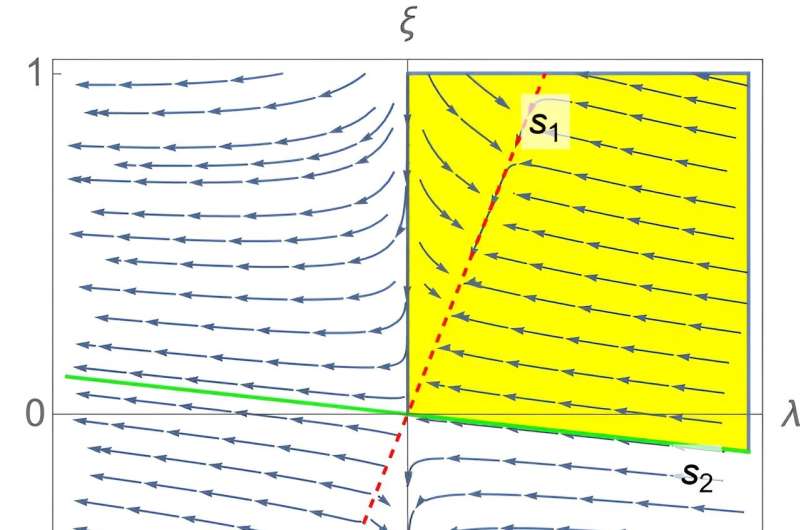July 31, 2024 feature
This article has been reviewed according to Science X's editorial process and policies. Editors have highlighted the following attributes while ensuring the content's credibility:
fact-checked
peer-reviewed publication
trusted source
proofread
A new technique to calculate the physical running of couplings in quadratic gravity

Researchers at the International School for Advanced Studies in Trieste, University of Massachusetts, and Instituto de Física Teórica at Universidade Estadual Paulista in Brazil recently introduced an alternative approach to derive the correct physical beta functions of couplings in quadratic gravity. Their paper, published in Physical Review Letters, could contribute to the use of the theory of quadratic gravity for describing a wide range of gravitational phenomena.
"Quadratic gravity is a renormalizable quantum field theory which is a potential candidate to describe gravity on all scales," John Donoghue, co-author of the paper, told Phys.org. "In various combinations, we have been exploring the running of coupling constants in simpler theories than gravity."
Quadratic gravity theory is an extension of Einstein's general theory of relativity, which introduces local terms quadratic in the curvature to the Einstein-Hilbert action. This theory is of great importance, as it could potentially address some of the limitations of classical and quantum gravity theories, allowing physicists to better explain various gravitational phenomena.
Donoghue and his colleagues had previously been calculating the running of coupling constants in other well-established physical theories. As part of their recent work, they set out to calculate the physical running of couplings in quadratic gravity, described in terms of the so-called "beta function."
"As the beta function usually gives us the flow of a quantum field theory (QFT) from one scale to another, it might also provide us with additional hints on the high-energy behavior of the theory," Gabriel Menezes, co-author of the paper, told Phys.org. "A correct understanding of the physical beta function is thus of utmost importance."
When the energy associated with a quantum amplitude changes, the appropriate coupling constant describing the interaction that is taking place also changes (i.e., "runs"). This change in a coupling constant, also referred to as the running of a coupling constant, can be calculated mathematically using various methods.
"Several techniques have been developed to calculate this running, which normally yield equivalent results," Donoghue explained. "In quadratic gravity, they do not all agree. We have developed new techniques which track the running of the couplings of physical amplitudes within quadratic gravity."
Donoghue, Menezes and their colleagues introduced new beta functions to derive the running of couplings in quadratic gravity theory. Using their proposed approach, they were able to gather new insight about quantum gravity theory, which could inform future studies.
"It is generally felt that the theories that behave best at high energy are ones where the running couplings do not grow uncontrollably as the energy increases," Donoghue said. "One of the main implications of our work is that it is possible for the couplings of quadratic gravity to run to vanishingly small values at high energy (i.e., to be asymptotically free)."
The recent work by this research group shows that quadratic gravity theory can describe phenomena marked by remarkably low coupling constants, without the emergence of a class of unstable particles known as tachyons. The team's results further emphasize the potential of quadratic gravity as a complete theory of quantum gravity.
"As a quantum field theory, quadratic gravity also has some peculiarities that are not well delineated, and these require a better understanding," Donoghue said. "In a broader picture, quadratic gravity fits in a larger framework of quantum field theories of gravity, and there is much that needs to be understood about all these theories."
The new techniques introduced by Donoghue and his colleagues could soon be used to broaden the understanding of further gravitational phenomena and theories. Eventually, the researchers' efforts could contribute to the establishment and validation of a quantum field theory of gravity.
"A real understanding of the high-energy behavior and the analytic structure of scattering amplitudes--or more importantly, cross-sections in quadratic gravity--would be a major breakthrough and we are definitely interested in such topics," Menezes added.
More information: Diego Buccio et al, Physical Running of Couplings in Quadratic Gravity, Physical Review Letters (2024). DOI: 10.1103/PhysRevLett.133.021604
Journal information: Physical Review Letters
© 2024 Science X Network





















